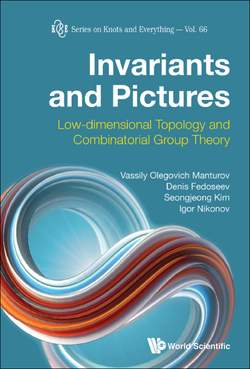Читать книгу Invariants And Pictures: Low-dimensional Topology And Combinatorial Group Theory - Vassily Olegovich Manturov - Страница 20
На сайте Литреса книга снята с продажи.
2.1Definitions of the braid group
ОглавлениеBelow, we are going to give some definitions of the braid groups and to discuss some of their properties.
First we consider a geometrical definition of the braid group. Consider the lines {y = 0, z = 1} and {y = 0, z = 0} in 3 and choose m points on each of these lines having x–coordinates 1, . . . , m.
Definition 2.1. An m-strand braid is a set of m non-intersecting smooth paths connecting the chosen points on the first line to the points on the second line (in arbitrary order), such that the projection of each of these paths to Oz represents a diffeomorphism.
These smooth paths are called strands of the braid.
An example of a braid is shown in Fig. 2.1. It is natural to consider braids up to isotopy in 3.
Definition 2.2. Two braids B0 and B1 are equal if they are isotopic; i.e., if there exists a continuous family Bt, t ∈ [0, 1] of braids starting at B0 and finishing at B1.
Definition 2.3. The set of (isotopy classes of) m-strand braids generates a group. The operation in this group is just juxtaposing one braid under the other and rescaling the z-coordinate.
Fig. 2.1A braid
The unit element or the unity of this group is the braid represented by all vertical parallel strands. The inverse element for a given braid is just its mirror image; see Fig. 2.2.
Fig. 2.2Unity. Operations in the braid group
Definition 2.4. The Artin m-strand braid group1 is the group of braids with the operation defined above. The braid group is denoted by Br(m).
The second definition of the braid group considered in the present chapter is an algebraic definition.
Definition 2.5. The m-strand braid group is the group given by the presentation with (m − 1) generators σ1, . . . , σm−1 and the following relations
for |i − j| ≥ 2 and
for 1 ≤ i ≤ m − 2.
These relations are called Artin’s relations.
Definition 2.6. Words in the alphabet of σ’s and σ−1’s will be referred to as braid words.
In fact, those two definitions give the same object:
Theorem 2.1. The two definitions of the braid group Br(m) given above are equivalent.
Proof. In order to prove the equivalence of the definitions, let us introduce the notion of the planar braid diagram.
To see what it is, let us project a braid on the plane Oxz.
In the general case we obtain a diagram that can be described as follows.
Definition 2.7. A braid diagram (for the case of m strands) is a graph lying inside the rectangle [1, m] × [0, 1] endowed with the following structure and having the following properties:
(1)Points (i, 0) and (i, 1), i = 1, . . . , m, are vertices of valency one; there are no other graph vertices on the lines {z = 0} and {z = 1}.
(2)All other graph vertices (crossings) have valency four.
(3)Unicursal curves; i.e., lines consisting of edges of the graph, passing from an edge to the opposite one, go from vertices with ordinate one and come to vertices with ordinate zero and descend monotonously.
(4)Each vertex of valency four is endowed with an over and undercrossing structure.
Obviously, all isotopy classes of geometrical braids can be represented by their planar diagrams. Moreover, after a small perturbation, all crossings of the braid can be set to have different z-coordinates.
It is easy to see that each element of the geometrical braid group can be decomposed into a product of the following generators σi’s: the element σi for i = 1, . . . , m − 1 consists of m − 2 segments connecting (k, 1) and (k, 0), k ≠ i, k ≠ i + 1, and two segments (i, 0) − (i + 1, 1), (i + 1, 0) − (i, 1), where the latter goes over the first one; see Fig. 2.3.
Different braid diagrams can generate the same braid. Thus we obtain some relations in σ1, . . . , σm−1.
Let us suppose that we have two equal geometrical braids B1 and B2. Let us represent the process of isotopy from B1 to B2 in terms of their planar diagrams. Each interval of this isotopy either does not change the disposition of their vertex ordinates, or in this interval at least two crossings have (in a moment) the same ordinate; in the latter case the diagram becomes irregular.
Fig. 2.3Generators of the braid group
We are interested in those moments where the algebraic description of our braid changes. We see that there are only three possible cases (all others can be reduced to these ones). The first case gives us the relation σiσj = σjσi, |i − j| ≥ 2 (this relation is called far commutativity), or an equivalent relation , in the second case we get , and in the third case we obtain one of the following three relations:
Obviously, each of the latter two relations can be obtained from the first one. This simple observation is left to the reader as an exercise. This completes the proof of the theorem.
